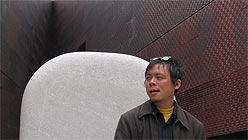Last summer I visited Intersection for the Arts to see an installation by artists Weston Teruya and Michele Carlson that resembled a chaotic classroom. While discussing the project with curator Kevin B. Chen, I learned that he was nearing his ten-year anniversary at the organization, so I asked Kevin some questions to learn more about his contributions to our local arts community.
KF: Briefly tell us what Intersection for the Arts is all about.
KC: Intersection is a multi-disciplinary arts space based in the Mission District. Established in 1965, we are one of the oldest non-profit alternative arts spaces in the country, and the oldest one in San Francisco. We currently develop, support and present work in a number of different disciplines — visual arts, theater, dance, jazz, literature, interdisciplinary projects — as well as incubating and supporting dozens of projects and small organizations throughout the Bay Area with our Incubator Program. In the history of Intersection, there were also moments in time where other fields and disciplines were supported, like stand-up comedy, film, and experimental music. Intersection started off in the Tenderloin as a merger of several faith-based experiments that were using art to reach disenfranchised neighborhood youth while also providing artists who were conscientious objectors with an alternative to serving in the Vietnam War. Intersection found its first home in the basement of a church in North Beach, where it was located for the first twenty years and was initially called Intersection: A Center for Religion and the Arts. There hasn’t been a religious affiliation since the early 1970s, but it is an interesting history, when forward-thinking members of the church were positioning art to help build-up and construct community when it was being so devastated by the social and political upheavals of the 1960s.
KF: Describe your role at the organization and how it has evolved over the past ten years. Also, how has your personal aesthetic valuing process evolved during your time at IFTA?
KC: I didn’t have formal training to curate and organize projects. I learned a lot of it on the job. One of the great things that we’ve been able to do is to provide a lot of development space and time for artists to realize their vision in the actual building itself, whether it’s upstairs in the gallery or downstairs in the theater. We frequently work with artists who want to create new work, and we’ve been fortunate to be able to provide the framework where that work can organically grow and develop in front of our eyes. I have a very hands-on approach to working with artists, helping them out in whatever way possible to realize an exhibition or installation. I’m a practicing artist myself, and over the years I’ve also learned a ton about installation techniques and the best ways to work the particular physical layout of our gallery. I wouldn’t even think twice about staying late to work with an artist, and…[giving] as much they do [in] realizing the idea. Because of this, my own personal aesthetic valuing process has definitely morphed over the years. It has been an incredible learning experience…being exposed to the many different ways in which artists approach their work and how they execute their ideas and thoughts. Now, after 10 years and over four dozen exhibitions and installations later, I feel like I value the process more than what ultimately winds up in the gallery on the night of the opening reception.


